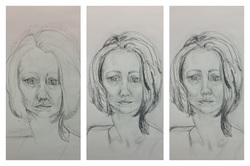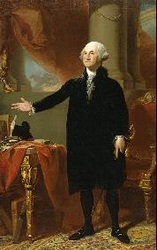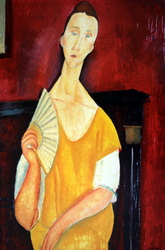|
Today was kinetic sculpture day with Meryl Tardash. Meryl is a college professor and sculptor working with kinetic, or moving, artwork. She has had the opportunity to produce a number of public art pieces, many of which make us of mobile structures. I found today to be a huge challenge because of the patience required to find balance points. Patience is not my forte but Meryl had patience to spare and helped me to grasp the idea of asymmetrical balance. We talked a great deal about the work of Alexander Calder and how he was the first artist to create suspended works. Meryl spent time explaining the science behind kinetic works of art and specifically the physics of asymmetrical balance (d(istance) X w(eight) = w X d). I have a friend who infuses his physics class with art by having the students build functional mobiles and I would like to pursues
0 Comments
Yeah... So, today the amazing people at PAFA gave our small group of art educators a tour of the storage area - aka the basement. There are 4 main "vaults" and a print room. As you may suspect, this behind the scenes glimpse into the life of art objects is thrilling and emotionally charged. PAFA has some awesome work stored in the basement!
Each vault has a series of racks made of chain link. These racks slide in and out to view and access the works hung on the links. In the last vault the registrar had 3 large Warhol prints leaning against the cage racks. I was carefully walking around the Warhol to peak into a stowed rack of early American paintings and accidentally nudged the Warhol's ground support with my foot. It tipped ever so slightly and I thought it was going to fall. Thankfully, it did not. Needless to say, I kept my distance from that point on. I'll tie this post to my teaching practice by saying I will have a bit more understanding in the future when a student breaks something of little value in the art room. All in all, the PAFA summer program was a refreshing and inspiring week of professional development. I can't stress enough how valuable time like this is to my teaching practice and to my sanity.  Despite being extremely tired and leaving the house late, I managed to get to PAFA early for Thursday’s session. I found myself alone, with my self. Well, self portrait that is… I saw a resemblance of me in the image, but somehow older and more frail. Was this some sort of psychological message I was sending about my “self” or had I screwed up the image in some subtle, yet meaningful, way that produced the aged, fragile appearance? I got down to business measuring my face and comparing those measurements to the image using a pencil, a mirror, and my thumb. Turns out, though there may be some deep hidden psychological truth in my decrepit representation of self, I had actually drawn my nose way too long. This simple and relatively small mistake altered the entire image in a significant way. This was not a difficult fix – technically speaking. However, taking an eraser to a basically complete drawing that didn’t look horrible was a bigger emotional challenge than I had expected. I felt a strong sense of empathy for my students as I began erasing my hard work to make corrections. This is one of the greatest challenges in the art room – realizing that fixing it is more important that being done with it… and also, realizing that it is worth the time to make those corrections – not only for that image, but for future images as well. I am so thankful that I took these W.I.P. shots so I can see and remember the changes that were made to create the final image. Having this collection of progress shots will also be helpful to share the transformation of this drawing with my students. Realizing that my nose was too long was only the tip of the lesson I learned from today’s drawing, Today began with more ecorche carving. As we finished our work, we discussed how knowledge and understanding of the musculature of the face improves portraiture. We were instructed to begin work on a self portrait from observation using our knowledge of facial muscles.
Now, let me say this: I do not enjoy drawing portraits, and more specifically, I loathe drawing SELF portraits. I'm not sure where my displeasure with this task started but my main complaint is the difficulty - portraits are not easy. My experience today was very different. I felt like I was building my face in the drawing by focusing on the planes created by the muscles below the skin. This approach to portraiture has changed my thoughts on this genre of art and I feel strongly that there will be talk of facial musculature in my lessons this year. Over the years I have made it a priority to reinvest in my teaching practice by attending workshops, seminars, conferences and classes that relate to art education. Sometimes these professional development opportunities are theoretical and other times they are materials based. This week, I am attending the Summer Academy for Teachers at the Pennsylvania Academy of Fine Arts (PAFA). If you are unfamiliar with PAFA and their offerings, I urge you to visit their website for more information. The focus of this year's program revolves around the museum's collection of historical American paintings. I saw this as a chance to learn some new approaches to teaching art history, collaborate with other art educators, and spend some time being inspired and making art (the program leans heavily on art making - yay!). I also felt this was a great opportunity to expand my knowledge of this genre of art history - our 8th grade Social Studies Curriculum focuses on American History and I try to collaborate within my building as much as possible. Today we started the day with a brief tour of the museum. Our guide refreshed our understanding of Visual Thinking Strategies (VST) using Benjamin West's monumental painting, Death on the Pale Horse. VST is a great technique for looking at art with children because there are no wrong answers. VST is also an invaluable tool for today's learner as it helps to increase visual literacy. We also spent some time comparing and contrasting two of the museum's portraits of George Washington. In the afternoon, we visited the studios and began work on a grid enlargement drawing. This may sound odd and you may be asking yourself, "what art teacher doesn't know how to do this?" Well, you are correct, and I would bet that ALL art teachers know how to do this and have taught their students using grid enlargement at some point during their career. However, PAFA's summer academy is open to any TEACHER, thus not all of the participants are working as art educators.
I chose to work from Modigliani's La femme a l'eventail. Having three hours of uninterrupted time to draw was glorious. This is a luxury I do not often allow myself and I found the experience to be refreshing and inspiring. I'm not quite finished, but you can see the progress and the resemblance. I increased the image size by 2.5 - the drawing is 15 by 23.75 inches. |
Lora DurrMiddle School Art Educator. Adjunct Art Education Professor. Non-Profit Arts Organization Board Member. Artist. Arts Advocate. Dog-Mom. CrossFit Enthusiast. Archives
October 2015
Categories
All
Other BLogging Art EducatorsThe Art of Education
The Luminous Page The Teaching Palette That Little Art Teacher Art Teachers Hate Glitter Adventures of an Art Teacher Mrs. Art Teacher Art with Mr. E Art is Basic Art Makes Kids Smart And, if you want more... visit Artists in Blogland for a full directory of art teacher blogs! |






 RSS Feed
RSS Feed


